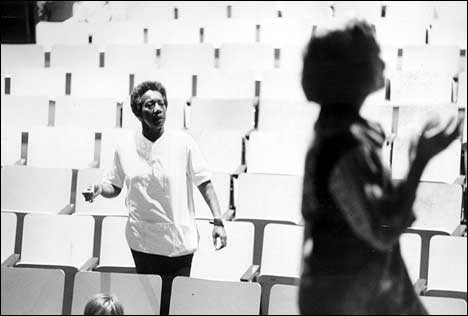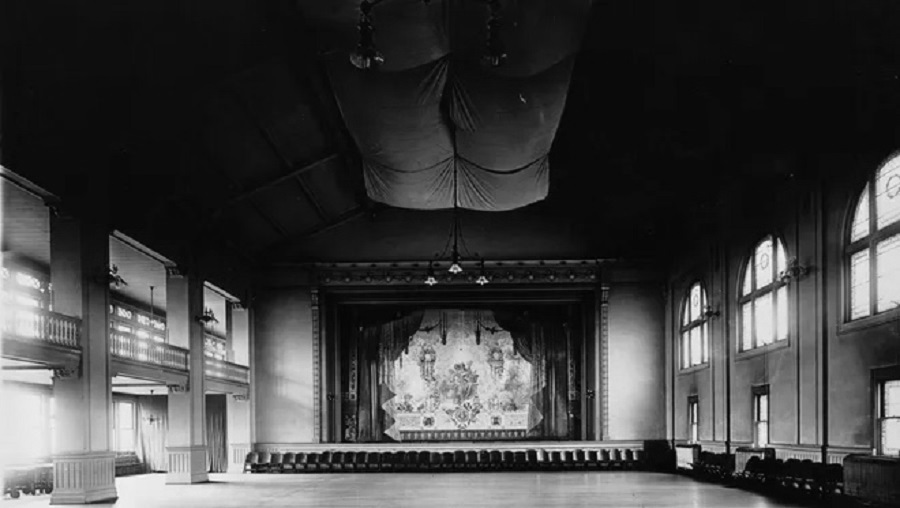March 1822 (200 years ago)
English-born actor George Horton Barrett, known as Gentleman George because of his elegance and grace on and off stage, performed at New York City’s Park Theatre for the first time as an adult. Barrett had grown up the son of actors who worked in William Dunlap’s company. In 1798, when Barrett was just four years old, he appeared onstage at the Park Theatre in The Stranger, Dunlap’s translation of German playwright Kotzebue’s work. As an adult, Barrett became a popular and beloved comedic actor. When not acting, he worked as a theatre manager and stage manager in New York, Boston, and New Orleans. But acting was Barrett’s first love and he toured the nation with some of the most famous actors of the era, once playing Sir Andrew Aguecheek in a production of Twelfth Night with Charlotte Cushman as Viola.
March 1867 (155 years ago)
The original Winter Garden Theatre in New York City was completely destroyed by fire on March 23. The cause of the fire that finally demolished the building is unknown. Built in 1850, the theatre had hosted the most famous actors and theatre managers of the 19th century during its 17-year existence. More than $60,000 worth of costumes (the equivalent of $1 million-plus today) were destroyed in the fire, including the costume worn by Edwin Booth for his record-setting 100 consecutive nights as Hamlet. One of the most important productions at this Winter Garden had been a one-night performance of Julius Caesar, starring the three sons of Shakespearean actor Junius Brutus Booth: Edwin, John Wilkes, and Junius Brutus Jr., in the roles of Brutus, Marc Anthony, and Cassius respectively. The performance was a fundraiser with the goal of establishing a statue of Shakespeare in Central Park. Ironically, during the performance, Confederate sympathizers set fire to LaFarge House, an adjacent building. Edwin Booth calmed the audience when they heard the sirens from next door, preventing a possibly dangerous rush for the exits, and the performance continued. It was the first and only time that all three Booth brothers performed together onstage.
March 1907 (115 years ago)
San Francisco’s Van Ness Theatre, built for $200,000, opened on the southwest corner of Van Ness and Grove on March 11. It had a seating capacity of 1614 audience members. The opening performance was the English Opera Company’s Madama Butterfly. The opening afforded San Francisco society members an opportunity to turn up in full dress for the first time since the 1906 earthquake and subsequent devastation. But the structure was torn down only three years after opening, as the building was found to be too fragile and the location inappropriate. Now the Louise M. Davis Symphony Hall sits on the site.
March 1922 (100 years ago)

This month marks the 100th anniversary of the birth of trailblazing playwright, actress, and director Vinnette Carroll. Among her many accomplishments, Carroll was the first Black woman to direct a play on Broadway, the gospel revue Don’t Bother Me, I Can’t Cope, a show she both conceived of and directed. It opened at Ford’s Theatre in Washington, D.C., before transferring to Broadway in 1972, where it earned four Tony nominations and ran for over a thousand performances. Carroll got her start in theatre In 1948 when she left the study of psychology to attend Erwin Piscator’s Dramatic Workshop at the New School of Social Research (now New School University). There she studied with Lee Strasberg and Stella Adler, and was influenced by Brecht and Piscator to create her own style of folk drama. Carroll founded the Urban Arts Corps in 1967, a nonprofit whose mission was to create a repertory theatre that featured new work by underrepresented artists and to provide direct performing arts experiences to Black and brown communities. Carroll is quoted in a New York Times article in 1969 saying, “The deprivation imposed by the white community on the Black Artist is not only crippling to the Deprived, but also to the Depriver.” Carroll died at the age of 80 in Fort Lauderdale, Fla., where she had founded the Vinnette Carroll Repertory Company.
March 1972 (50 years ago)
This month the newly formed Indiana Repertory Theatre invited “all Indianapolis women interested in theatre” to a meeting at the Anthenaeum. Artistic directors Ed Stern and Ben Mordecai addressed the gathering of women and explained the importance of building a professional theatre in Indianapolis. IRT went on to open in the Fall of 1972 with a season of six plays which were performed at the Anthenaeum and then toured the state, visiting Indiana high schools and colleges. It is estimated that 30,000 Hoosier students saw a production by IRT during its first statewide tour. In 1980, IRT moved to its current home at the historic Indiana Theatre on Washington Street in Indianapolis. IRT continues as a regional theatre with a mission of providing “experiences that will engage, surprise, challenge, and entertain people throughout their lifetimes.” This month, they open Charles Smith’s play The Reclamation of Madison Hemings, a play about the son of Sally Hemings and Thomas Jefferson, set in 1866.


